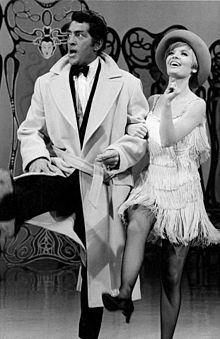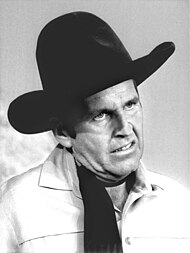
Rowan & Martin's Laugh-In is an American sketch comedy television program which ran for 140 episodes from January 22, 1968, to March 12, 1973, on the NBC television network, hosted by comedians Dan Rowan and Dick Martin. It originally aired as a one-time special on September 9, 1967, and was such a success that it was brought back as a series, replacing The Man from U.N.C.L.E. on Mondays at 8 pm (ET). It quickly became the most popular television show in the United States.

The Cosby Show is an American television sitcom created by and starring Bill Cosby that aired on NBC from September 20, 1984, to April 30, 1992, with a total of 201 half-hour episodes spanning eight seasons, including an outtakes special. The show focuses on the Huxtables, an upper middle-class African-American family living in Brooklyn, New York; the series was based on comedy routines in Cosby's stand-up comedy act, which in turn were based on his family life. The series was followed by a spin-off, titled A Different World, broadcast from 1987 to 1993 for 144 episodes in six seasons.
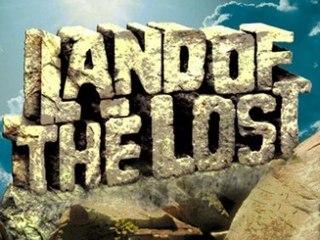
Land of the Lost is a children's adventure television series created by David Gerrold and produced by Sid and Marty Krofft, who co-developed the series with Allan Foshko. It is a live-action show mixed with stop-motion animated dinosaurs, originally aired on Saturday mornings from 1974 to 1976, on the NBC television network. CBS used it as a summer replacement series from June 22–December 28, 1985, and June 20–September 5, 1987. It has since become a 1970s American cult classic. Krofft Productions remade the series in 1991, and adapted it into a feature film in 2009.

Sid Krofft and Marty Krofft, known as The Krofft Brothers and born as Cydus and Moshopopoulos Yolas, were a Canadian sibling team of television creators, writers and puppeteers. Through their production company, Sid & Marty Krofft Pictures, they made numerous children's television and variety show programs in the U.S., particularly in the 1970s, including H.R. Pufnstuf, Land of the Lost, and Sigmund and the Sea Monsters. Their fantasy programs often featured large-headed puppets, high-concept plots, and extensive use of low-budget special effects.
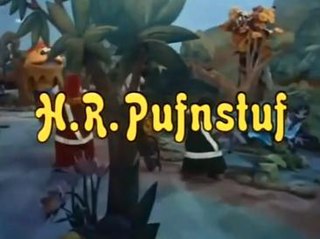
H. R. Pufnstuf is an American children's television series created by Sid and Marty Krofft. It was the first independent live-action, life-sized-puppet program, following on from their work with Hanna-Barbera's program The Banana Splits Adventure Hour. The seventeen episodes were originally broadcast Saturday from September 6, 1969, to December 27, 1969. The broadcasts were successful enough that NBC kept it on the schedule as reruns until September 4, 1971. The show was shot at Paramount Studios and its opening was shot at Big Bear Lake, California. Reruns of the show returned on ABC Saturday morning from September 2, 1972, to September 8, 1973, and on Sunday mornings in some markets from September 16, 1973, to September 8, 1974. It was syndicated by itself from September 1974 to June 1978 and in a package with six other Krofft series under the banner Krofft Superstars from 1978 to 1985. Reruns of the show were featured on TV Land in 1999 as part of its Super Retrovision Saturdaze Saturday morning-related overnight prime programming block and in the summer of 2004 as part of its TV Land Kitschen weekend late-night prime programming block, and it was later shown on MeTV from 2014 until 2016.
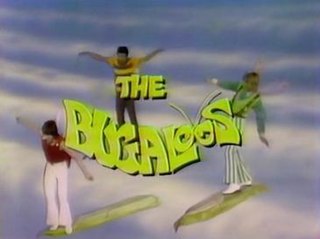
The Bugaloos is an American children's television series, produced by brothers Sid and Marty Krofft, that aired on NBC on Saturday mornings from 1970 to 1972. Reruns of the show aired in daily syndication from 1978 to 1985 as part of the "Krofft Superstars" package with six other Krofft series. The show features a musical group composed of four British teenagers in insect-themed outfits, constantly beset by the evil machinations of the talent-challenged Benita Bizarre, played by comedian Martha Raye.

A laugh track is an audio recording consisting of laughter usually used as a separate soundtrack for comedy productions. The laugh track may contain live audience reactions or artificial laughter made to be inserted into the show, or a combination of the two. The use of canned laughter to "sweeten" the laugh track was pioneered by American sound engineer Charles "Charley" Douglass.

Pink Lady is an American variety show that aired for five weeks on NBC in 1980, starring the Japanese musical duo of the same name. The show also is referred to by the title Pink Lady and Jeff, referring to co-star Jeff Altman. The show was riddled with complications, including a dispute over the name: agents for the starring parties were never able to settle on one, and the show was advertised both ways during its run. Other difficulties included scriptwriting disagreements, guest star booking mishaps, taping and touring conflicts, and the inability of Mie and Kei, the members of Pink Lady, to understand or speak English.
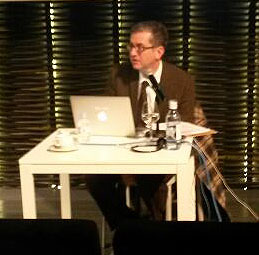
Gregory Martin Daniels is an American screenwriter, television producer, and director. He has worked on several television series, including writing for Saturday Night Live and The Simpsons, adapting The Office for the United States, and co-creating Parks and Recreation and King of the Hill. Daniels attended Harvard University, where he befriended and began collaborating with Conan O'Brien. His first writing credit was for Not Necessarily the News, before he was laid off because of budget cuts.

Marvin Ginsburg, known professionally as Greg Garrison, was an American producer and director in television.
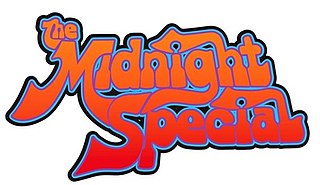
The Midnight Special is an American late-night musical variety series originally broadcast on NBC during the 1970s and early 1980s, created and produced by Burt Sugarman. It premiered as a TV special on August 19, 1972, and then began its run as a regular series from February 3, 1973, to March 27, 1981. The 90-minute program aired on Saturday mornings at 1 a.m. ET/PT after the Friday night edition of The Tonight Show Starring Johnny Carson.
The Golddiggers was a female singing and dancing troupe created for The Dean Martin Show. They performed on TV, live tours and internationally with the USO. The group was formed in 1968, dissolved in 1992, and reorganized in 2007, and has numbered between four to thirteen members over various time periods.

30 Rock is an American satirical sitcom television series created by Tina Fey that originally aired on NBC from October 11, 2006, to January 31, 2013. The series, based on Fey's experiences as head writer for Saturday Night Live, takes place behind the scenes of a fictional live sketch comedy show depicted as airing on NBC. The series's name refers to 30 Rockefeller Plaza in New York City, where the NBC Studios are located and where Saturday Night Live is written, produced, and performed. The series was produced by Lorne Michaels's Broadway Video and Fey's Little Stranger, in association with NBCUniversal.

The Colgate Comedy Hour is an American comedy-musical variety series that aired live on the NBC network from 1950 to 1955. The show featured many notable comedians and entertainers of the era as guest stars. Many of the scripts of the series are archived at the UCLA Library in their Special Collections.

The Krofft Supershow was a Saturday morning children's variety show, produced by Sid and Marty Krofft. It aired for two seasons from September 11, 1976, to September 2, 1978, on ABC.

Tom Gammill and Max Pross are an American comedy writing team. Together they have written episodes for the TV shows Seinfeld, The Critic, The Wonder Years, It's Garry Shandling's Show, and Monk. They have also worked as producers on The Simpsons and Futurama.
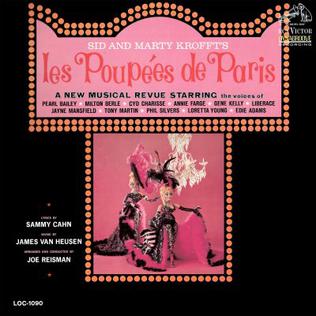
Les Poupées de Paris was a musical puppet show created, produced and directed by Sid and Marty Krofft, that toured the United States throughout the 1960s.

Community is an American television sitcom created by Dan Harmon. The series ran for 110 episodes over six seasons, with its first five seasons airing on NBC from September 17, 2009, to April 17, 2014, and its final season airing on Yahoo! Screen from March 17 to June 2, 2015. Set at a community college in the fictional Colorado town of Greendale, the series stars an ensemble cast including Joel McHale, Gillian Jacobs, Danny Pudi, Yvette Nicole Brown, Alison Brie, Donald Glover, Ken Jeong, Chevy Chase, and Jim Rash. It makes use of meta-humor and pop culture references, paying homage to film and television clichés and tropes.
Family Affair is a television comedy that aired on The WB from September 12, 2002 to March 13, 2003. It was a remake of the original 1966 television series. This version was from Sid and Marty Krofft, and was produced by Sid & Marty Krofft Pictures, Pariah Films, and Turner Television. The WB canceled the series after airing thirteen of the fifteen episodes produced.
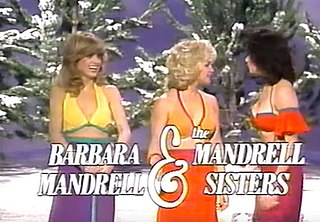
Barbara Mandrell & the Mandrell Sisters is an American variety show starring American country artist Barbara Mandrell, along with her sisters Irlene Mandrell and Louise Mandrell. The show ran for two seasons on the NBC network between November 1980 and June 1982. The program mixed both music and comedy sketches. The siblings often engaged in sketches involving their family relationship. The music of the show featured the sisters singing and playing a variety of musical instruments. Guest performers were also a part of every show. The show ended its run after Barbara Mandrell decided to step away due to the constant workload.
